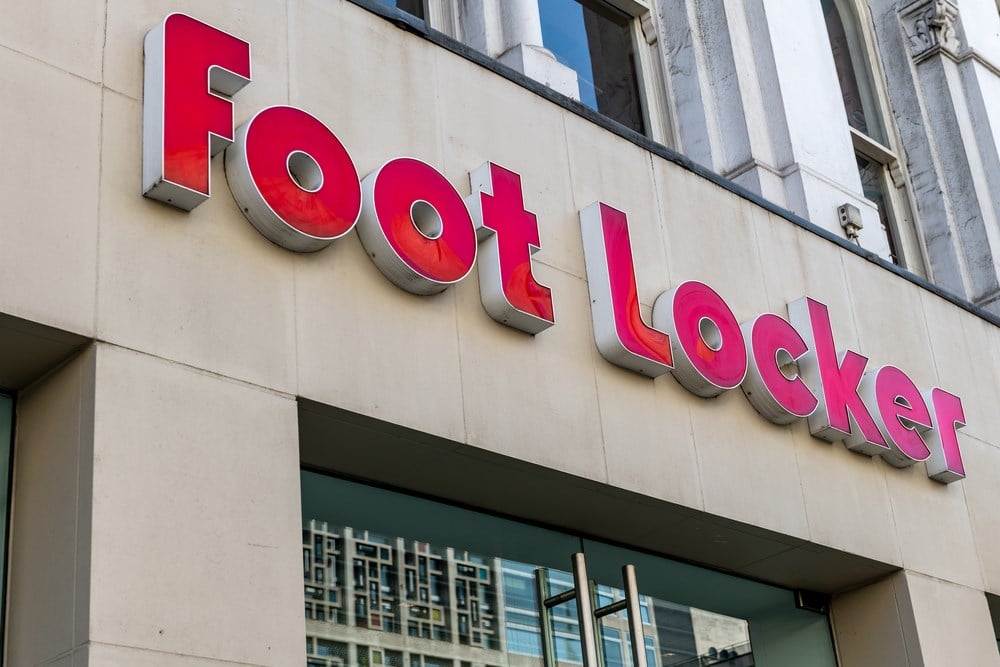
The dirty laundry keeps piling up for Foot Locker, Inc. (NYSE: FL). Last week, the athletic apparel and sporting goods retailer announced its sixth straight quarter of lower profits and the worst bottom line performance since Covid closures.
Although the result matched Wall Street expectations, a more bleak full-year outlook caused Foot Locker to gap down in high volume for the second time in three months. The drop erased what remained of the stock’s post-pandemic gains and put it at its lowest level since 2011.
Shoved into a locker by bearish bullies, Foot Locker had nowhere to hide when it came to explaining its latest bombshell. Elevated inventory levels forced markdowns to attract reluctant consumers still reeling from inflation and rising interest rates. Despite the promotional activity, second-quarter sales fell 9.9% to $1.86 billion. The Foot Locker, Foot Locker Kids and Champs Sports banners all recorded lower sales as did each geographic region. Along with management lowering its margin guidance to reflect “more aggressive markdowns,” silver linings were hard to find among the black and white stripes.
Foot Locker’s struggles aren’t unique. Clothing retailers like Burlington Stores, Express and The Children’s Place are getting beat up by the same industry headwinds. Abercrombie & Fitch and Urban Outfitters, on the other hand, are bucking the tide and appear well on the way to recovery.
So with Foot Locker backpedaling to a 12-year low of $17.21, investors may be wondering if this is a good time to step foot into a stock that used to trade in the $70’s — but things could get worse before they get better.
What Is Foot Locker’s Growth Outlook?
Last quarter, Foot Locker closed over 100 stores and opened 15. The high level of net closures is not a good sign, especially when some peers are expanding their footprints to accommodate current or anticipated demand.
The move does make sense. Fewer locations mean less overhead and lower labor costs, which will help offset slumping sales. However a reduced store count also increases the dependence on other sales channels, namely e-commerce. That’s where new CEO Mary Dillon comes in. The former Ulta Beauty
CEO has yet to replicate the digital growth she shepherded at the cosmetics retailer, a key reason she was brought in to spark a turnaround at Foot Locker. Putting lipstick on a pig isn’t attracting shoppers.
To be fair, Ms. Dillon stepped into a tough macro environment that will make boosting Foot Locker’s digital capabilities a lengthy process. Online sales traction will be a key theme for the company going forward. It faces an uphill battle, though with athletic apparel makers like Nike ramping up their direct-to-consumer businesses and the Amazon threat looming as large as ever.
Whether or not Foot Locker’s second half of 2023 gets off on the right foot will largely depend on the back-to-school shopping season. The National Retail Federation projects that K-12 and college school spending will jump 22% to $135.5 billion this year. Good news for Foot Locker — more than 40% of that money will go towards clothes and shoes. The retailer’s ability to grab a significant chunk of this spending will be a big factor in being able to deliver a third-quarter earnings surprise.
In addition to e-commerce, Foot Locker has much to prove when it comes to overseas growth. North American sales still account for approximately 70% of overall sales. With several emerging economies forecast to grow faster than the domestic economy this decade, a successful push into new international markets will be paramount for better financial results.
Is Foot Locker Stock Oversold?
By several technical analysis measures, Foot Locker looks oversold (even after the late week bounce). The 12 relative strength indicator (RSI) reading is one of the lowest in the consumer cyclical group.
In terms of valuation, the stock also appears to be cheap. FL trades around 7x trailing earnings compared to an industry average of 24x. Still, the shares will likely struggle to attract buyers for two reasons:
- The dividend will be suspended after the October 27th payout. Prior to last week’s drop, Foot Locker’s high dividend yield was a main attraction for value investors willing to take a chance on a depressed stock.
- Company fundamentals justify the depressed valuation. Aside from the negative growth and worsened outlook, Foot Locker’s balance sheet has deteriorated. As of July 29th, 2023, the cash position was $180 million, less than half of what it was a year prior. Meanwhile, the current $450 million debt balance is about the same as it was a year ago.
Pausing the dividend to shore up the balance sheet will help, but is only a Band-Aid. Only sales growth and sustainable profits will lead to healthier fundamentals. Foot Locker hasn’t figured out that combination.




